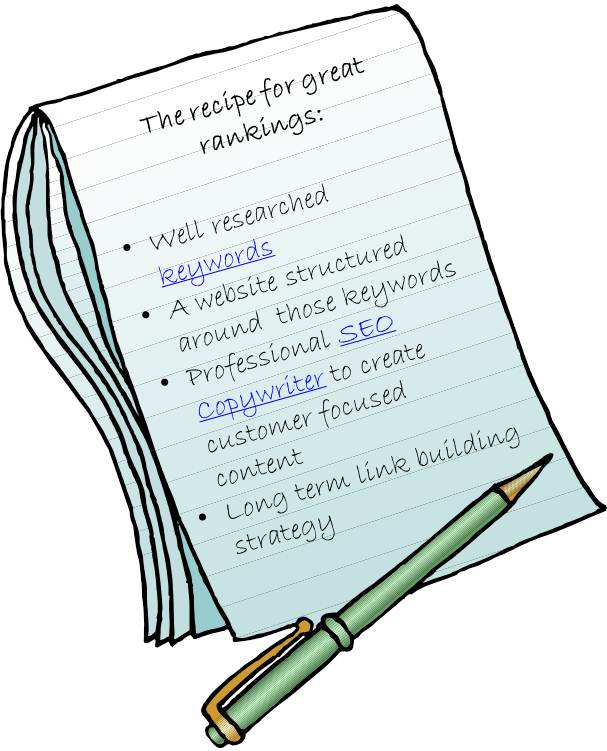Entries Tagged 'website copywriting' ↓
September 2nd, 2011 — conversion, internet marketing, online marketing, website copywriting, website design
 Does your website work?
Does your website work?
Do you get regular traffic?
Are you getting regular leads from your website?
When, at a networking event, I asked those three questions to a businessman and website owner, this was his response:
“I don’t have an ecommerce website, so that doesn’t apply to me. I have a website because everyone expects me to have one. It’s not as if businesses like mine sell through their website – that’s impossible.”
Unfortunately, thinking like that, he’s never likely to sell through his website. And if he isn’t getting any leads from it that would suggest his website is poorly built and poorly written.
An easy-to-use structure and well-written site will boost your conversion rate (assuming your SEO strategy is targeting the correct keywords). But there is another factor that is often ignored – the speed at which your website loads.
A slow loading website could lose you 7% of your potential conversions
According to a recent post on Bryan Eisenberg’s blog, a 1 second delay in your download speed could result in:
- 7% fewer conversions
- 11% fewer page views
- 16% decrease in customer satisfaction
There are several factors that can affect your load speed, for example image size, social media buttons or the size of your website.
The optimum download time is under two seconds (this will help improve your rankings significantly). So how do you get your site to load faster?
- Check your speed
If you don’t monitor your speed, you won’t know how well you are performing. Use tools such as Google Analytics to help you with this. Bryan also suggests a couple of his favourite tools: The Web Page Speed Report, Yahoo’s YSlow plugin, Google’s Page Speed plug-in, Loads In and WebPagetest.
There are others available but this will get you started.
Remember for every button and image you add to your website, you’ll be increasing the time it takes for your website to load.
- Coding
This one is for your web designer to look at for you. The coding of your site (HTML, CSS and JavaScript) can also have an effect on download speeds, so it’s best to chat to your designer about what can be done to tweak it.
- Images
Images and graphics look great on websites. They can be used to illustrate your products or they can make your text more impactful. But the more you use, the higher your load time.
Condensing your images, using the right format for the right task and reducing the overall number will help.
Why you need to know this
If you have a website, you would have invested heavily in it. Therefore, why would you not expect to see a return on that investment?
A website isn’t an online brochure. It is a powerful sales tool. Available 24/7, it offers potential customers a means to get to understand your company and what you can do for them.
Every businesses website should sell. It should bring in leads – in essence, it should be your 24 hour sales team.
If you’re not getting leads from your site ask yourself why not? Review the structure, content, load time, keywords and analytics.
A business with a website that isn’t performing is like a High Street store that keeps its door locked all the time.
Review your website today and make sure it’s working for you.
August 31st, 2011 — search engine optimisation, seo, SEO copywriter, seo website copywriter, website copywriter, website copywriting

From that list of ingredients, this post will look at the power of SEO copywriting.
When done well it will help your search engine rankings, attract readers and convert them into sales.
Done badly it could harm your rankings, repel customers and won’t convert a sausage.
So how can you make sure you get it right?
5 signs of good SEO copy
1. Write for your reader
There is a popular misconception that SEO copy has to be written for the search engines.
Wrong.
When writing your copy, always write it for your reader. Forget about keyword density – Google is more concerned with the amount of text, the topic you’re writing about (i.e. that your keywords in your title tags etc., are aligned with your content) and how hot the competition is for your particular keywords.
Always, always, always write to your reader first and foremost because they are the ones you want to read your copy and they are the ones you want to buy from you.
2. Don’t be repetitive
How many times have you read a website only to constantly hear the keywords being repeated?
Don’t stuff your copy with your keywords so it gets repetitive. After all if that was the only factor Google was interested in, all your competitor would have to do is insert one more keyword than you to rank higher.
And if that happened, the internet would be full of keyword-stuffed gibberish.
3. Don’t forget to link out
You already know the benefit of links into your website as part of your SEO strategy but don’t forget to link out too.
Linking out to authoritative articles not only adds to your reader experience and keeps Google happy; it could also help you attract inbound links.
4. Structure
Writing for the web is just like writing for anything else.
Your copy must be structured and attractive to the eye if you want people to read it.
Make sure it has a beginning, middle and an end with a strong headline. Split up your text into small paragraphs using sub headings as sign posts to help your reader skim the text.
Also, headings and subheadings are the ideal places for your primary and secondary keywords.
5. Be natural
There are loads of software programmes out there than can automate or spin articles for you. But they are no substitute for a well-considered, well-structured and well written article.
Don’t be tempted to use shortcuts.
So the moral of this post is to forget keyword density when it comes to your SEO copy. The most important thing to remember is to write for your reader. They are the ones you want to attract and they are the ones who you want to buy from you
August 10th, 2011 — Google, Google algorithms, internet marketing, online marketing, website copywriting
 It’s very true when people say nothing in life ever stays the same.
It’s very true when people say nothing in life ever stays the same.
If you’re into internet marketing you will definitely appreciate that. Google is constantly changing its algorithms. One minute your website could be riding high, the next it could be sinking fast.
But Google doesn’t do it just to be difficult. As a search engine, Google’s number one priority is its users. The constant changes occur to improve the quality of its search results. This is what Google said about the latest change:
“The “Panda” algorithm change has improved rankings for a large number of high-quality websites, so most of you reading have nothing to be concerned about. However, for the sites that may have been affected by Panda we wanted to provide additional guidance on how Google searches for high-quality site. Think about…
- Would you trust the information presented in this article?
- Is this article written by an expert or enthusiast who knows the topic well, or is it shallower in nature?
- Does the site have duplicate, overlapping, or redundant articles on the same or similar topics with slightly different keyword variations?
- Would you be comfortable giving your credit card information to this site?
- Does this article have spelling, stylistic, or factual errors?
- Are the topics driven by genuine interests of readers of the site, or does the site generate content by attempting to guess what might rank well in search engines?
- Does the article provide original content or information, original reporting, original research, or original analysis?
- Does the page provide substantial value when compared to other pages in search results?
- How much quality control is done on content?
- Does the article describe both sides of a story?
- Is the site a recognized authority on its topic?
- Is the content mass-produced by or outsourced to a large number of creators, or spread across a large network of sites, so that individual pages or sites don’t get as much attention or care?
- Was the article edited well, or does it appear sloppy or hastily produced?
- For a health related query, would you trust information from this site?
- Would you recognize this site as an authoritative source when mentioned by name?
- Does this article provide a complete or comprehensive description of the topic?
- Does this article contain insightful analysis or interesting information that is beyond obvious?
- Is this the sort of page you’d want to bookmark, share with a friend, or recommend?
- Does this article have an excessive amount of ads that distract from or interfere with the main content?
- Would you expect to see this article in a printed magazine, encyclopaedia or book?
- Are the articles short, unsubstantial, or otherwise lacking in helpful specifics?
- Are the pages produced with great care and attention to detail vs. less attention to detail?
- Would users complain when they see pages from this site?”
(Source: http://googlewebmastercentral.blogspot.com/2011/05/more-guidance-on-building-high-quality.html)
In essence, if you focus on publishing high quality content that your readers will want to read and share, you should be OK.
7 Pillars of good websites
To sum up what Google are talking about, here are 7 tips to help you enjoy some great rankings:
- Make sure your website’s content is aimed at your reader at all times (not the search engines)
- Your content must focus on quality not quantity
- The links to your site must be quality links
- Keep it social – although there is no direct evidence as to how this will help your rankings, Google is now providing real-time social sharing in its search results
- Don’t duplicate content across websites as Google will only show the most relevant and original content
- Don’t overdose on advertisements on your website
- Make sure your title tags and META descriptions tell Google what your site is about (and make them meaningful and not just stuffed with your keywords)
So there you go – make sure you write for your reader and not the search engines.
I think I’ll give Google the last word:
“Our advice for publishers continues to be to focus on delivering the best possible user experience on your websites and not to focus too much on what they think are Google’s current ranking algorithms or signals”
Sally Ormond – copywriter, blogger and social media addict who’s rather partial to toffee
July 13th, 2011 — Branding, marketing, website copywriting, website design
 Do you understand what your brand is?
Do you understand what your brand is?
You do? Great, write it down as succinctly as you can.
Now you have your idea of what your brand is written down, let’s look at what a brand really is and see if you were right.
Knowing your brand
If you run a business you probably spent a huge amount of time thinking about your brand when you started out. That would have equated to spending hours with a graphic designer to come up with a cool-looking logo.
Once that was done, you’re next job was to find a web designer and begin work to create a funky website that had all the latest gadgets and gizmos. Your logo was inserted into the header and there you go, your business was launched.
Was that it?
You have a logo, you have a website and therefore you have a brand?
[Take a look at what you wrote down at the start of this post – did you say logo?]
It’s not necessarily that straight forward.
Your brand is a lot more than just your logo. Branding is all about colour, graphics, words, design, perception, and it’s about you.
Are your values shining through?
Let’s go back a step or two.
Before you even begin to think brands, you have to understand your business and its values and who your customers are and their needs. That’s a lot to get your head round but it is vital if you’re to position yourself correctly in the market.
If you don’t understand your customers how can you position yourself correctly to attract them?
After all you’re aiming your products and services at them so the way they are ‘packaged’ has to meet their needs and expectations.
This packaging includes:
– Your website copywriting and look
– Marketing materials
– Business cards
– Logo
– You
Surprised by the last one?
You shouldn’t be.
When in front of a potential customer, you are your business and your brand. If you don’t match the image your business portrays online (or through your literature) the disparity will be unnerving for your customer and give off mixed messages.
Let me elaborate – if your website projects a classic, well presented image and you turn up in jeans and a t-shirt your ‘brand’ won’t gel.
A consistent and well thought out brand will instil trust. If your website reflects your business’ values and activities through its words and design, your customer will instantly understand what you are offering them. It will give them an idea of how expensive you are likely to be, how open and approachable you are and whether you are a progressive company.
A fluid brand
Your brand will also be fluid.
If your business has been going for a few years I bet your customer base has changed. That means your brand must also reflect that change.
Therefore it is a good idea to revisit your brand every few years to ensure it is still giving a true picture of your business. That doesn’t necessarily mean you have to change your logo, although it may be something to think about if it no longer represents your business’ ethos.
This is me at the moment:

As you can see my marketing materials and website aren’t singing from the same hymn sheet anymore. Although my website has done me well over the past few years, my client base has moved on since it was designed.
Now I have to rethink my image and market position to align my brand with the market I am now working with.
It’s a scary process and, at times, uncomfortable. Take my logo for example. I am rather attached to it and want to keep it. My proposed new website design is far more contemporary than my present one and I feel it would sit well within it. Especially as my new site will be more ‘social’ (i.e. more focus on social media). After all, if you look at my logo it has the appearance of a social media ‘button’ – very forward thinking considering it was designed over 3 years ago!
Take a good look at yourself
Once you realise the complexity of your brand you can then start to work on your image and that of your business to project a uniform message.
Branding isn’t something that always gets the attention it deserves. In fact this post was prompted following a recent branding workshop I attended. As usual it’s not until someone else points these things out to you that you realise there’s a problem.
Branding is so much more than a logo.
Does your personal and company image gel or are you sending mixed messages? Please leave a comment and share your take on branding and how you arrived at the look you have for your business.
July 6th, 2011 — copywriting tips, marketing, online marketing, website copywriter, website copywriting, website design
 That might sound like a strange question to ask.
That might sound like a strange question to ask.
But think about it for a second – why do you have a website?
If your immediate answer is ‘because everyone else has one’ you’re barking up the wrong tree.
Yes, if you’re in business today you are expected to have a web presence but that shouldn’t be the sole reason for your website to exist.
Your website has to do something for you and, more importantly, something for your customers. Let me explain.
Your website and you
By having an effective presence on the web you will be able to:
Free up manpower because your website should answer most of your customers’ questions
- Be a source of information 24/7
- Help people find you on the internet
- Publicise events and your latest news
- Showcase you products and services
- Take orders online
And that’s just for starters.
But it’s not just about that. Yes, all of those things will make your life easier and, to a certain extent, your customers’ lives. But your website isn’t just there to help you.
Your website and them
Who is ‘them’?
They are your customers. Your website is a 24 hour a day, 7 days a week interface between you and your customers. As such it must speak to them directly, address their needs and show them what you can do for them.
When they land on your website they want:
Great service
You see, for your customers the most important thing is what you’re going to do for them so first impressions are vital.
First impressions count
Whether you already have a website or are in the early stages of development, here are a few pointers to bear in mind when thinking about its design:
- Does it reflect you and your values?
- Can your customer tell what you do from the design/layout?
- Are your contact details easy to find?
- Does your website reflect your brand values?
- Does the copy talk to your reader?
- Is it selling you or the benefits of your service?
- Is it social?
When someone first lands on your website they should be able to instantly see what you do. Your website copy should be benefits led and your site navigation should be easy to use.
Also, make sure your contact details are prominent – after all, your customer is going to want to know that they can get hold of you if they need to. But you also need to consider social media. If it’s right for your business you must use social media – customers expect it. Make sure they can easily interact with you via Twitter and Facebook as well as via the telephone and email.
If you still think a website is just an online brochure, think again. Today your website must work for you. It has to show you are a progressive company that has embraced social media to open up the lines of communication with your customers.
It should be your primary marketing tool so make the most of it.
 Does your website work?
Does your website work?
 It’s very true when people say nothing in life ever stays the same.
It’s very true when people say nothing in life ever stays the same. Do you understand what your brand is?
Do you understand what your brand is?
 That might sound like a strange question to ask.
That might sound like a strange question to ask.




